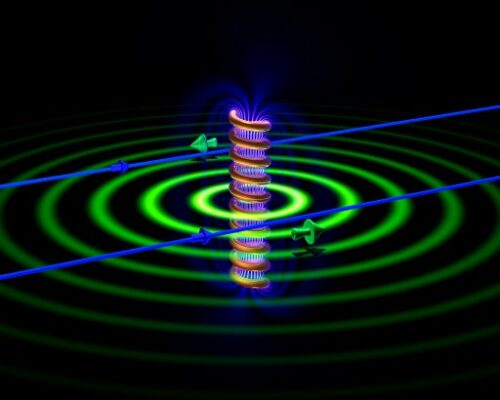Image courtesy of Physics World.
From the collapse of supermassive black holes to phase shifts induced by electromagnetic fields, atom interferometers can measure how the fields surrounding us impact particles. But could it be possible to measure how potentials, the very basis from which fields are derived, actually impact particles? This possibility questions our classical understanding of electromagnetism, gravity, and how quantum mechanics plays into our understanding of the world.
But what even is quantum mechanics? In brief, quantum mechanics picks up where classical physics leaves off—explaining the seemingly odd interactions of particles. One of the most principal concepts in quantum mechanics arose from the double-slit experiment, which showcased that light and matter can exist as a particle and as a wave that can be affected by electromagnetic and gravitational interactions. These interactions are still being explored by physicists today who explore how the potential of fields can impact particles, as well as the equivalence principle, which states that there is no difference between gravitational forces and accelerating reference frames.
In this study, Stanford physicists experimentally observed the Aharonov-Bohm effect—a quantum mechanical effect where the wave of a particle is shifted by the potential of the field around it. While this effect has been measured as a result of electromagnetic interactions, which produced tiny wave shifts that could be measured by the arms of an interferometer, it had not been previously experimentally proven to be true for gravitational interactions. Utilizing an existing 10-meter interferometer, the group shot rubidium atoms through a dense tungsten ring. This source mass acted as a source of gravitational potential for one of the arms of the interferometer, ultimately inducing a phase shift due to gravitational interactions with the packet of atoms shot through the tungsten ring while leaving the packet of atoms traveling through the other arm unaffected. “For a long time, we have been asking what really is quantum, and can we characterize a methodology of using atom interferometry to characterize the gravitational interaction?” said Mark Kasevich, principal investigator and former professor in the Yale Department of Physics. These results showcase how a particle’s interaction with gravitational potential can create wave shifts in the same manner as an interaction with electromagnetic potential.
This experiment is leading both the effort to tie our classical understanding of physics to the quantum world and the search for real-world applications of quantum mechanics. For instance, the gravitational constant, which many of us know as roughly 6.674×10 −11
m3 ⋅kg−1 ⋅s−2, still holds many mysteries. “This experiment shows that quantum mechanical effects show up in gravity,” Chris Overstreet, first author of the study, said. This experiment could establish the groundwork to measure gravity more precisely and potentially uncover hidden mysteries of physics in the process.
Kasevich also highlighted the humanitarian and economical applications of their research. Since atom interferometry is so adept at measuring small changes in gravitational gradients, it can be applied as a very powerful tool from space to precisely measure gravity and material density on Earth. “With climate change, that’s a big deal. By using satellite gravity gradiometers, you see where water and other resources are located,” Kasevich said, indicating that this technology can drive the discovery of valuable resources and better our understanding of the factors influencing global phenomena like climate change.
Ultimately, with an understanding of the quantum interactions in our world, we can create better predictions and new discoveries.

